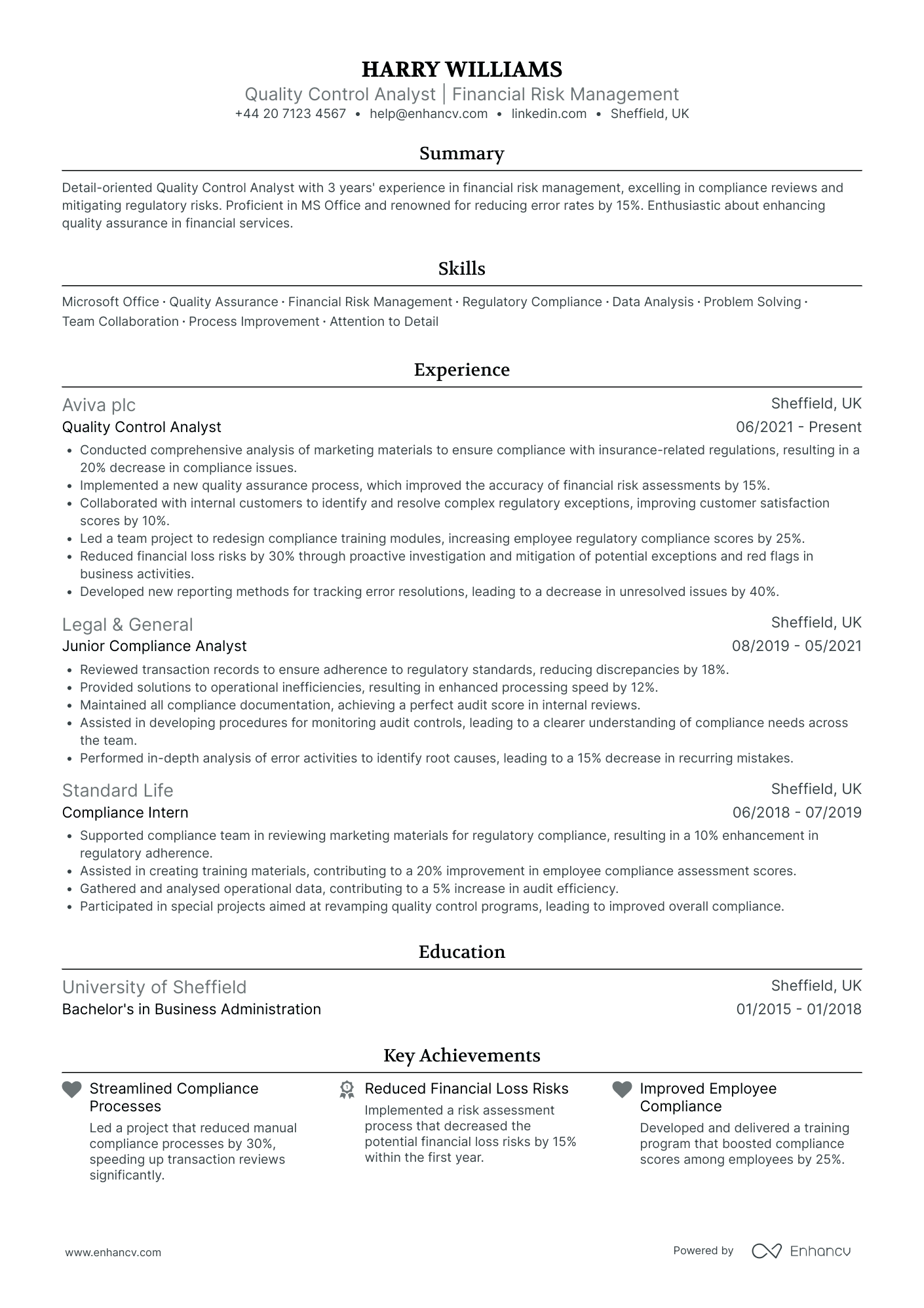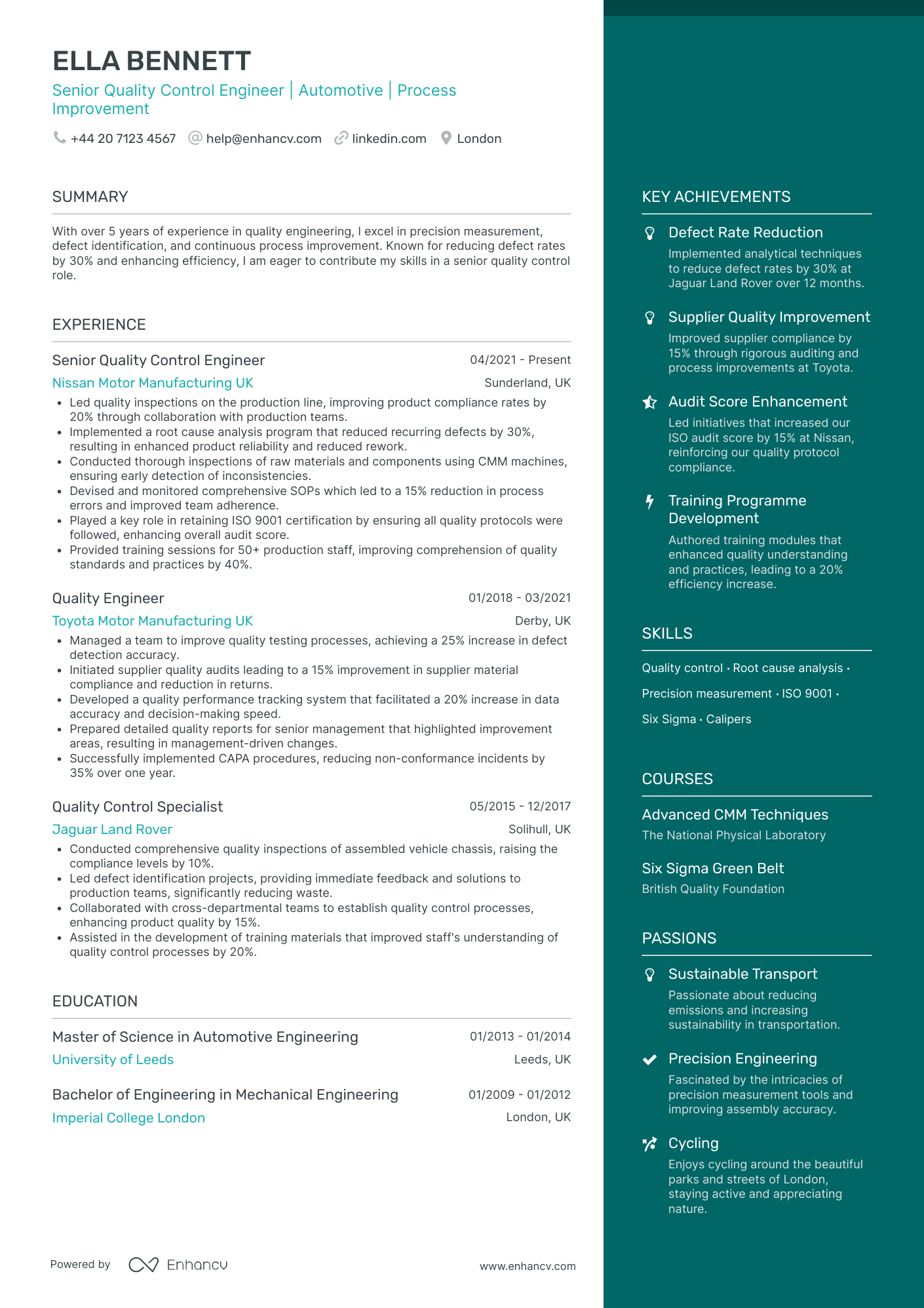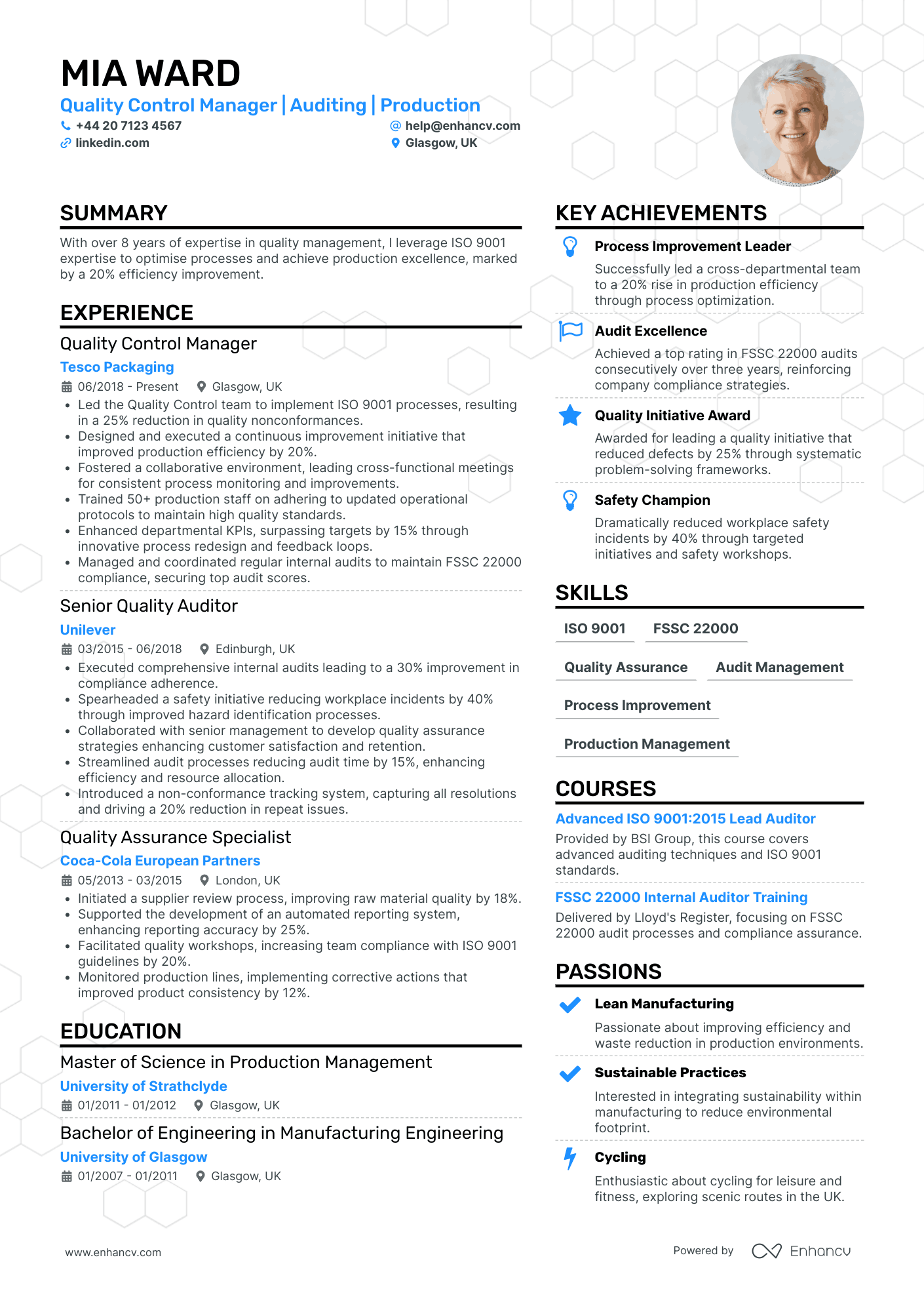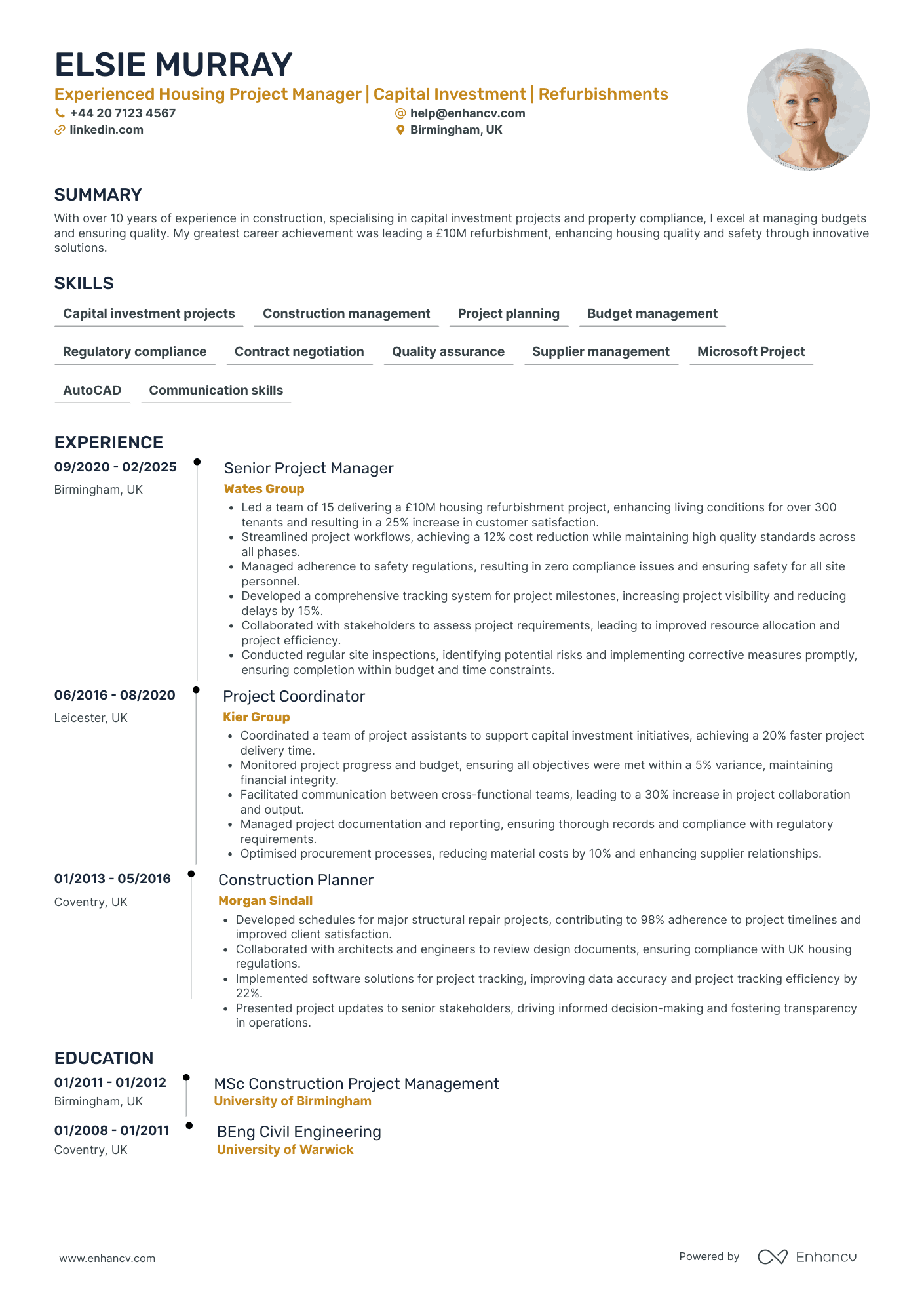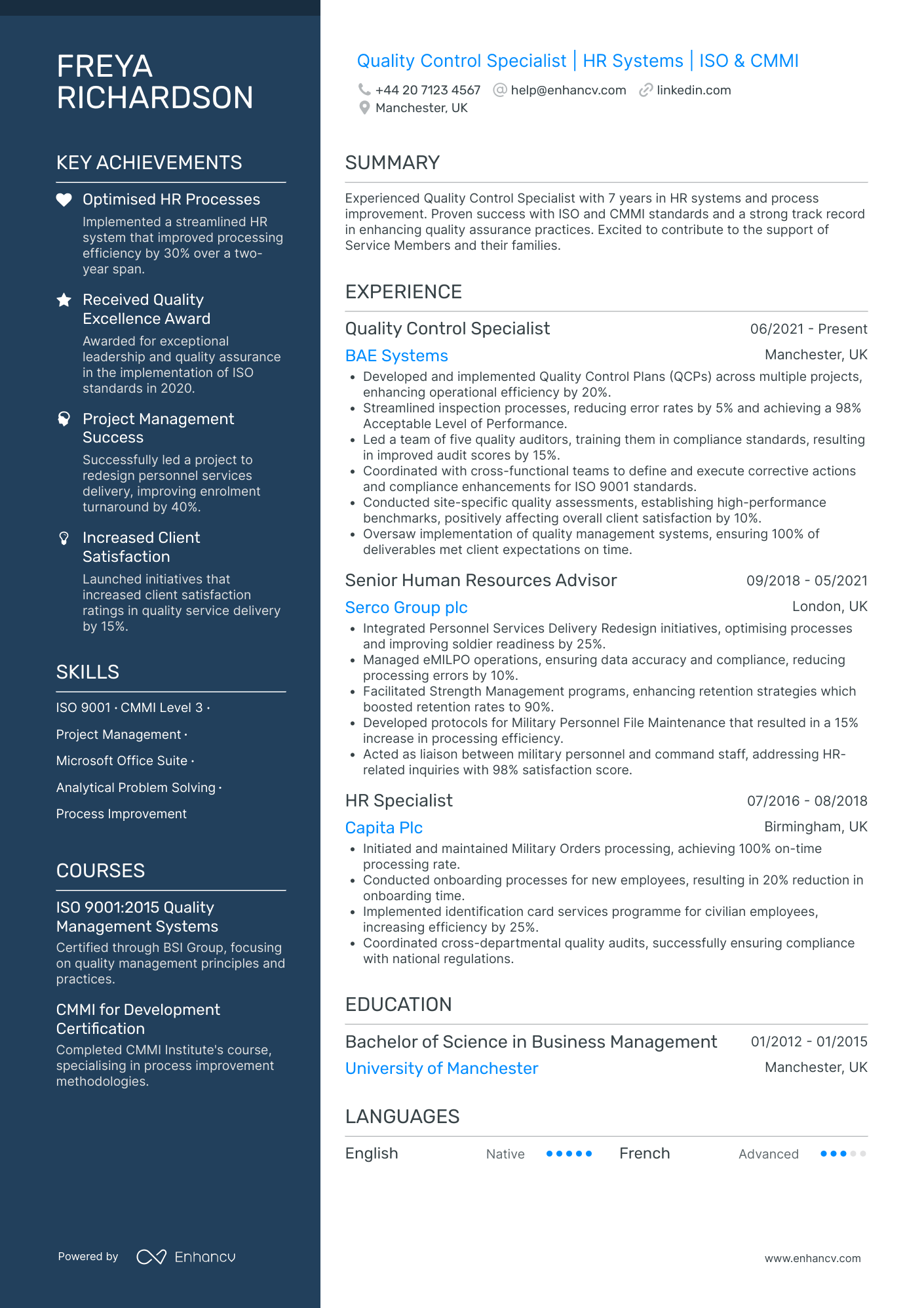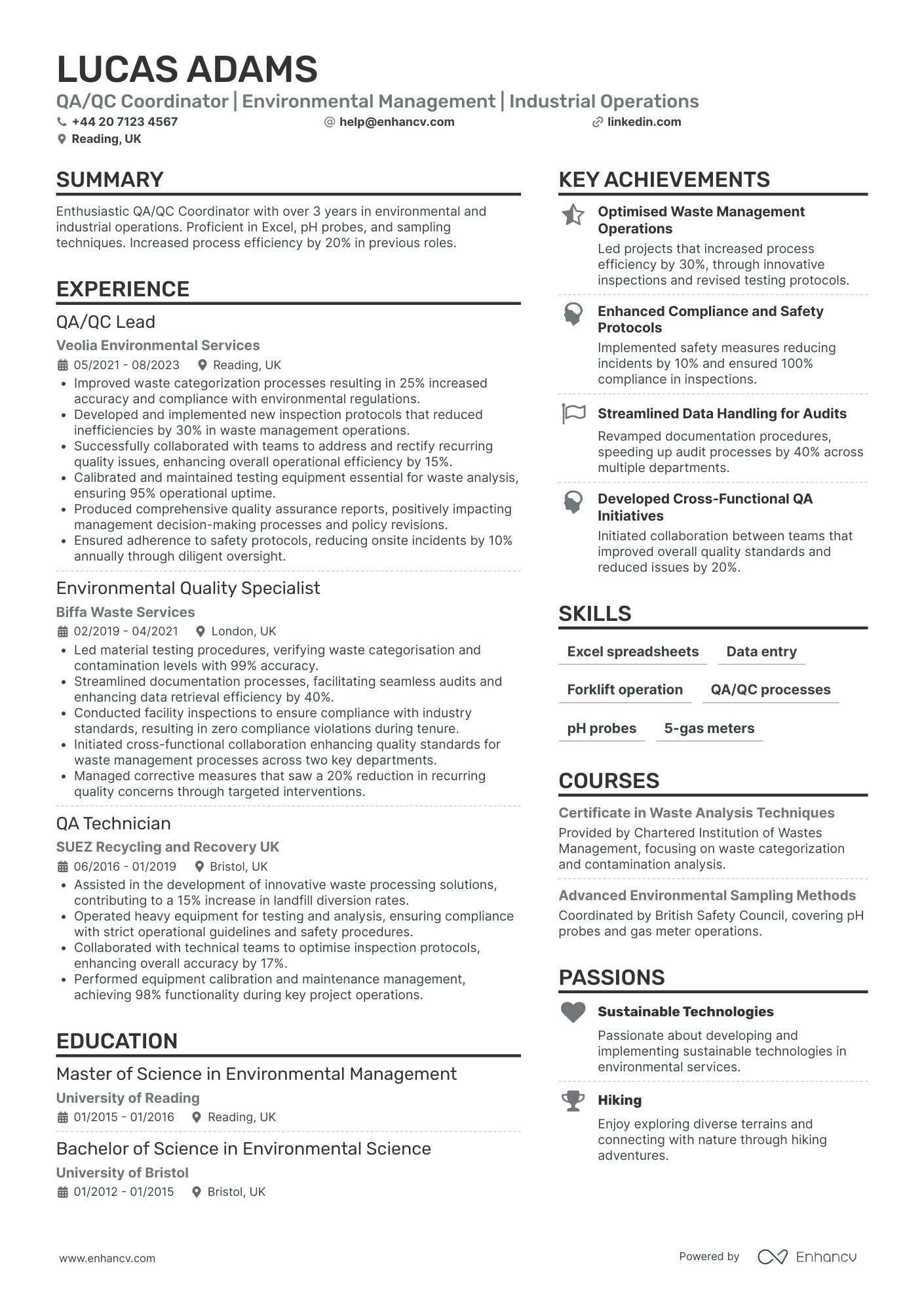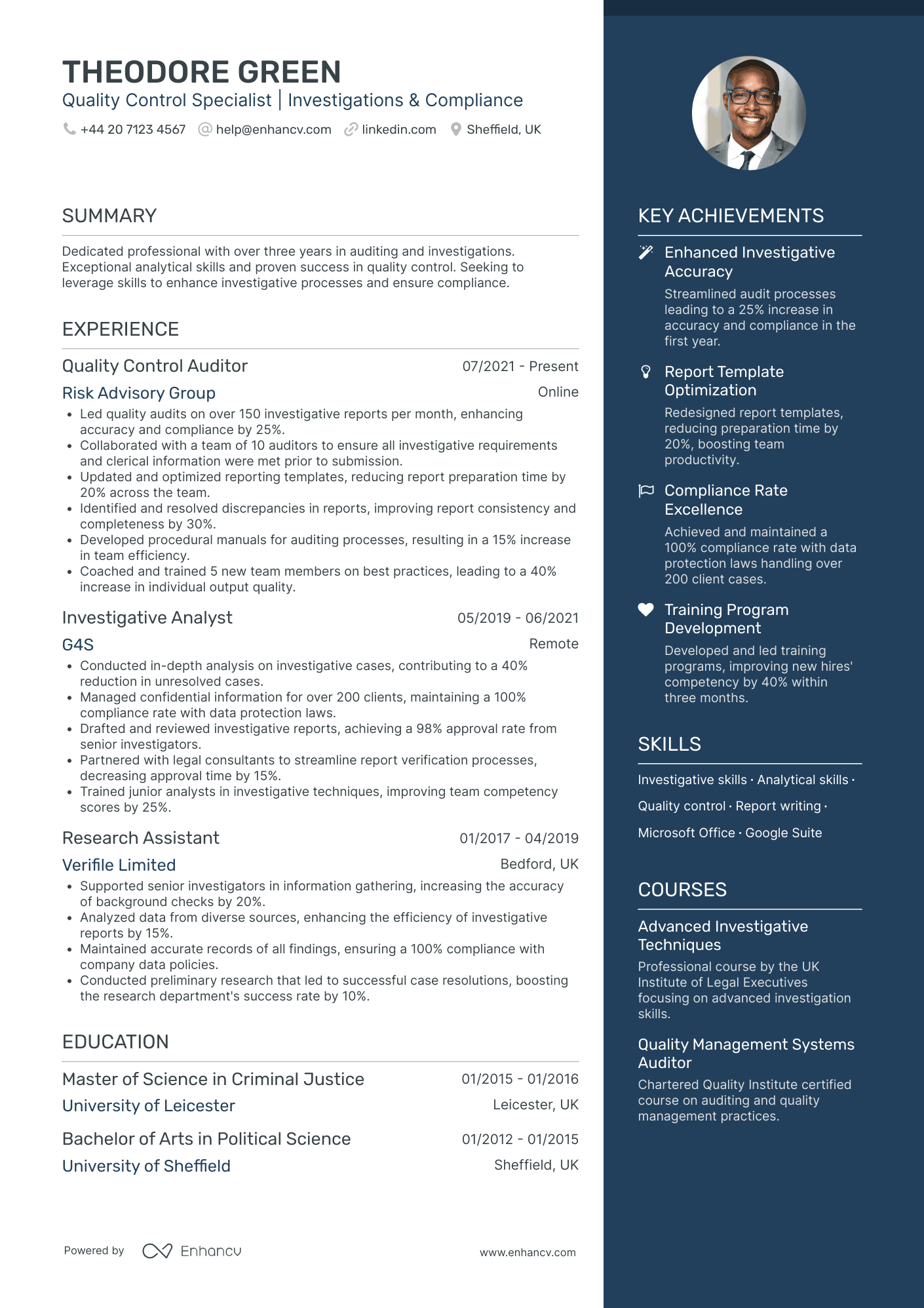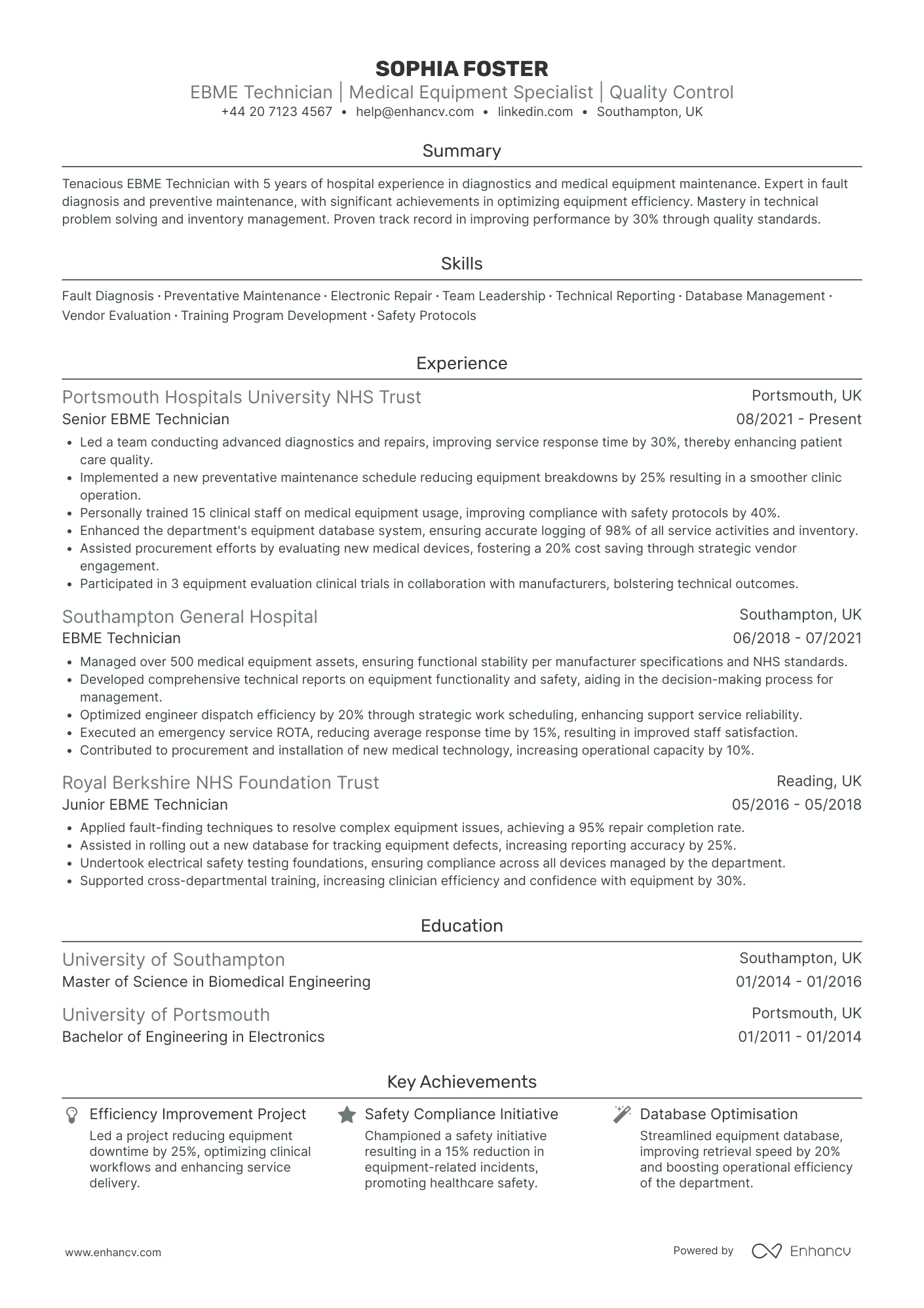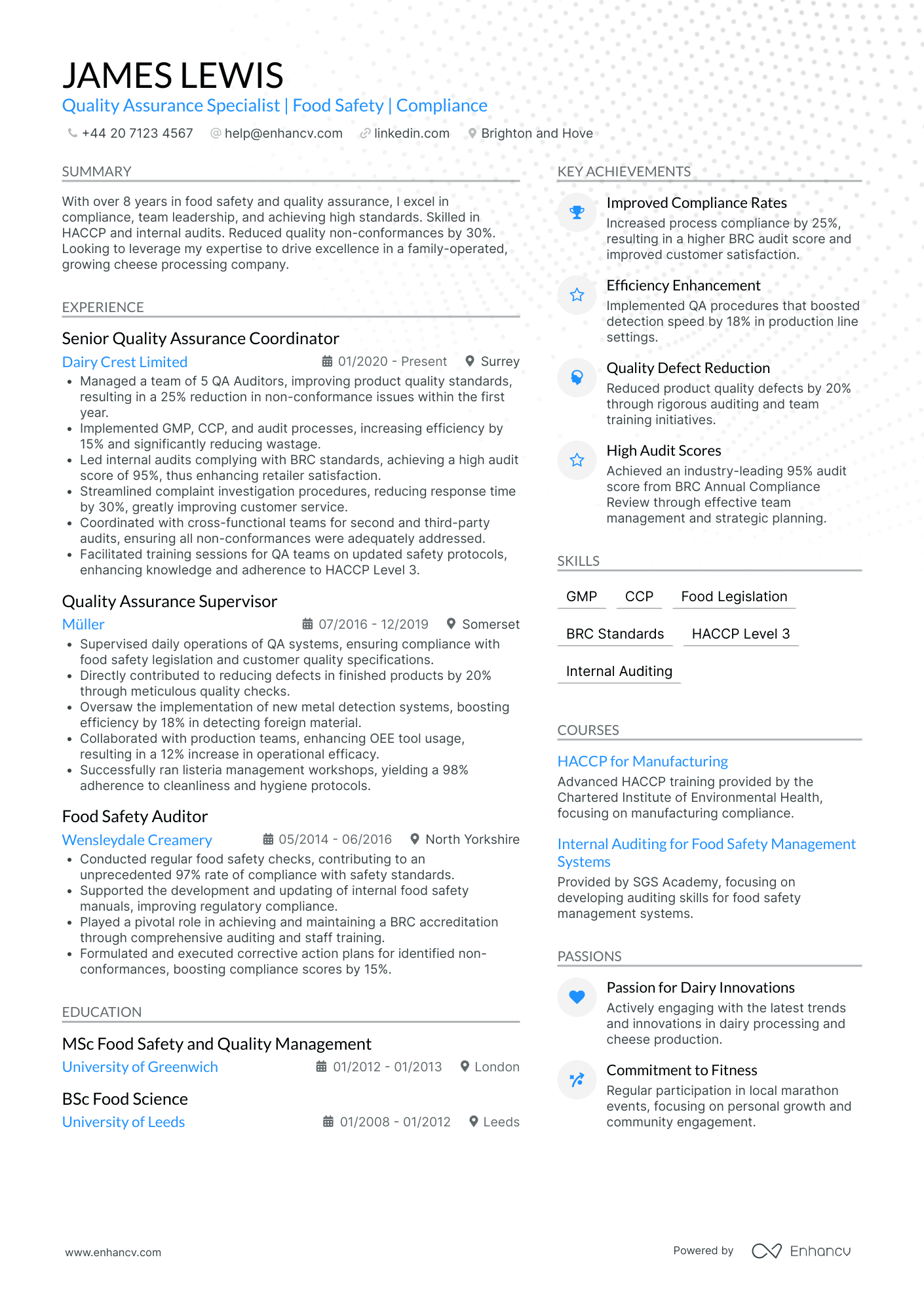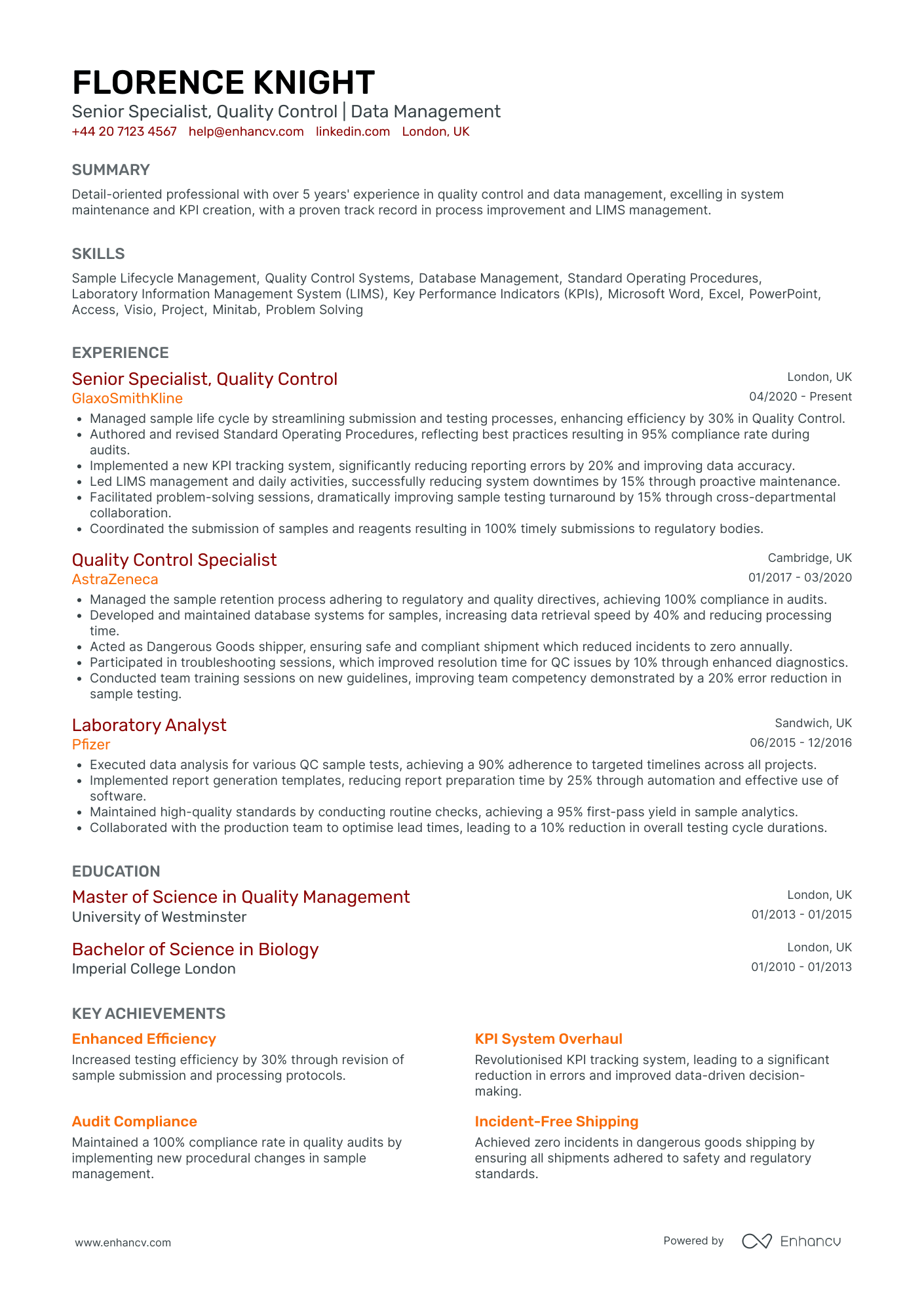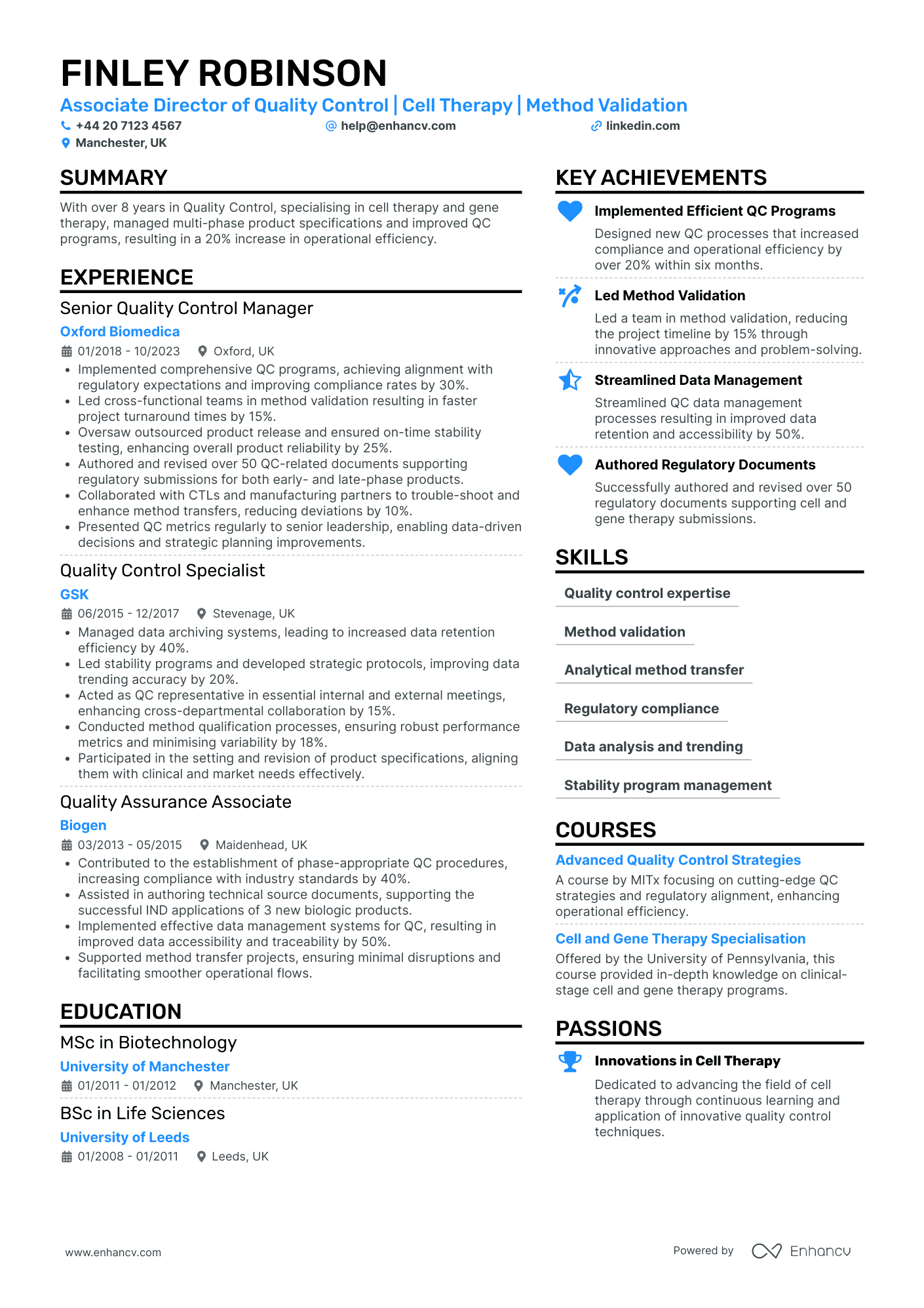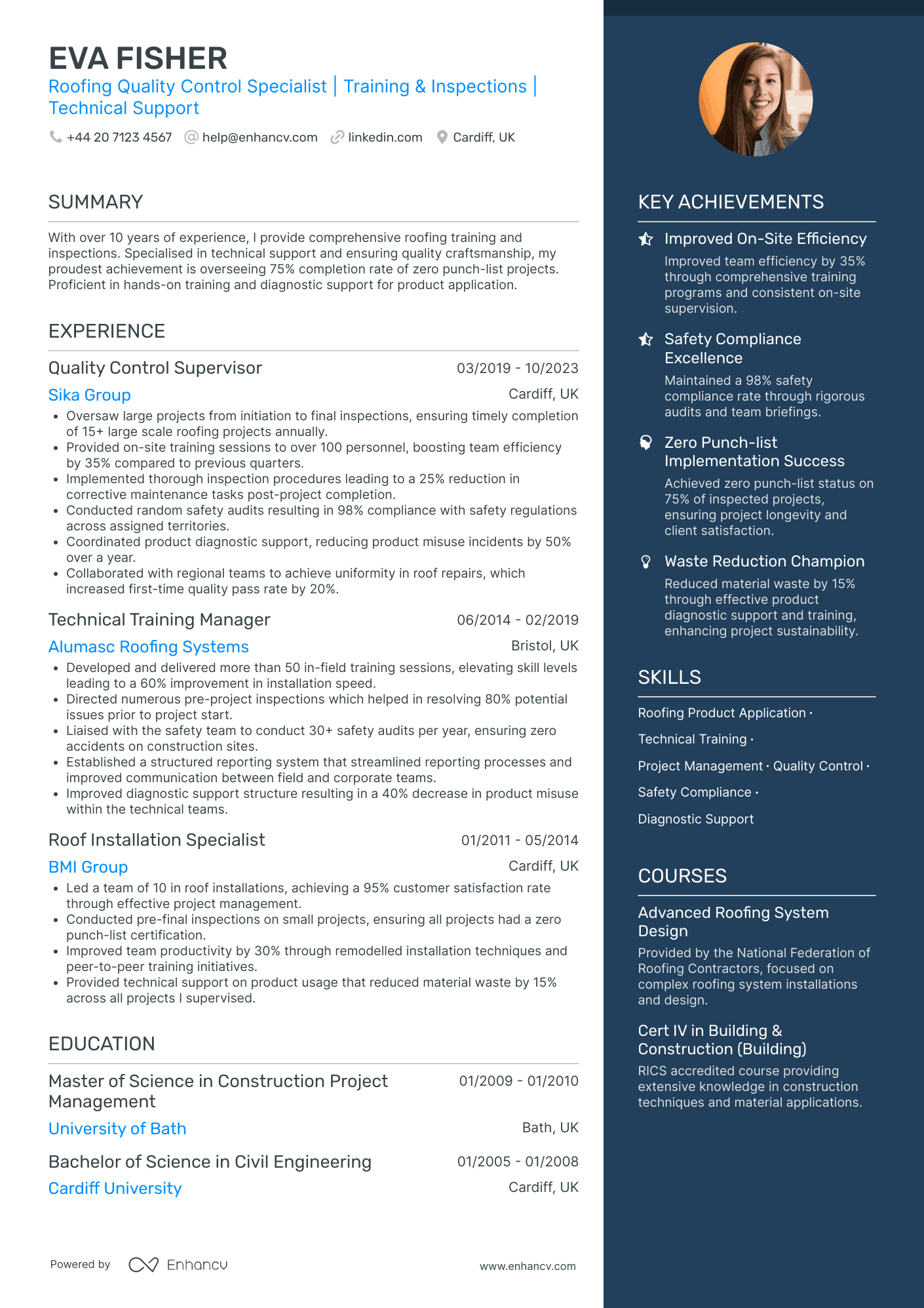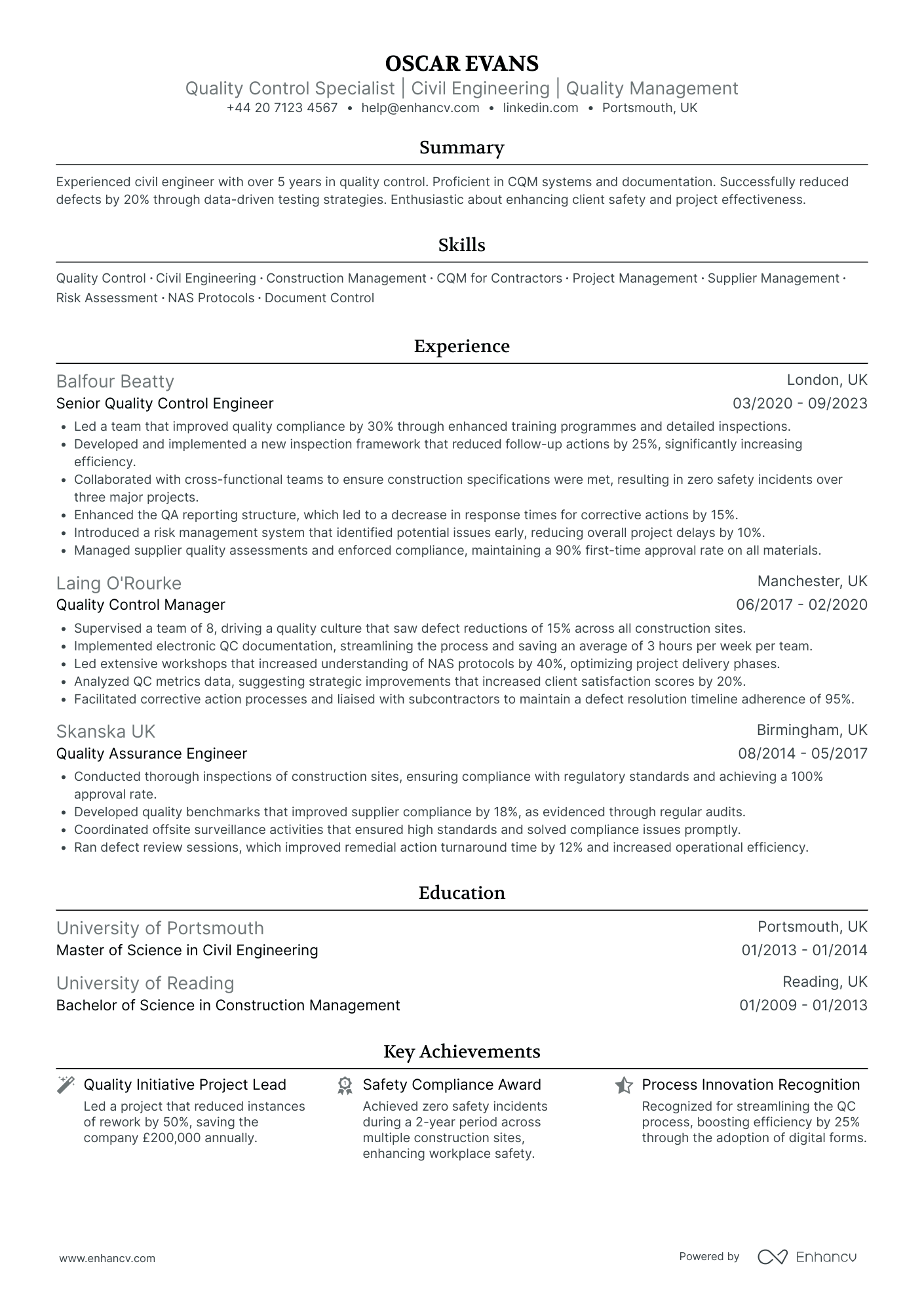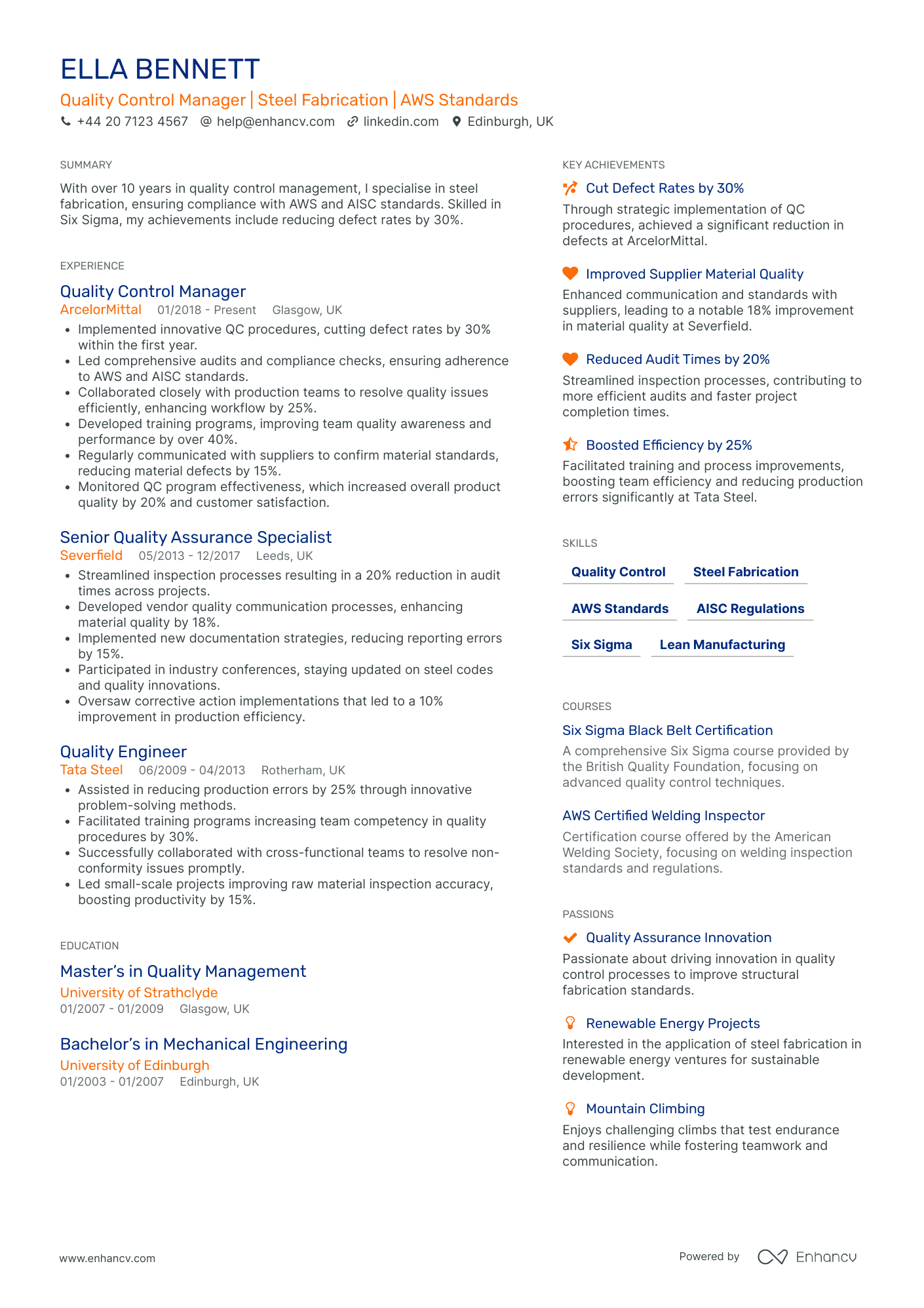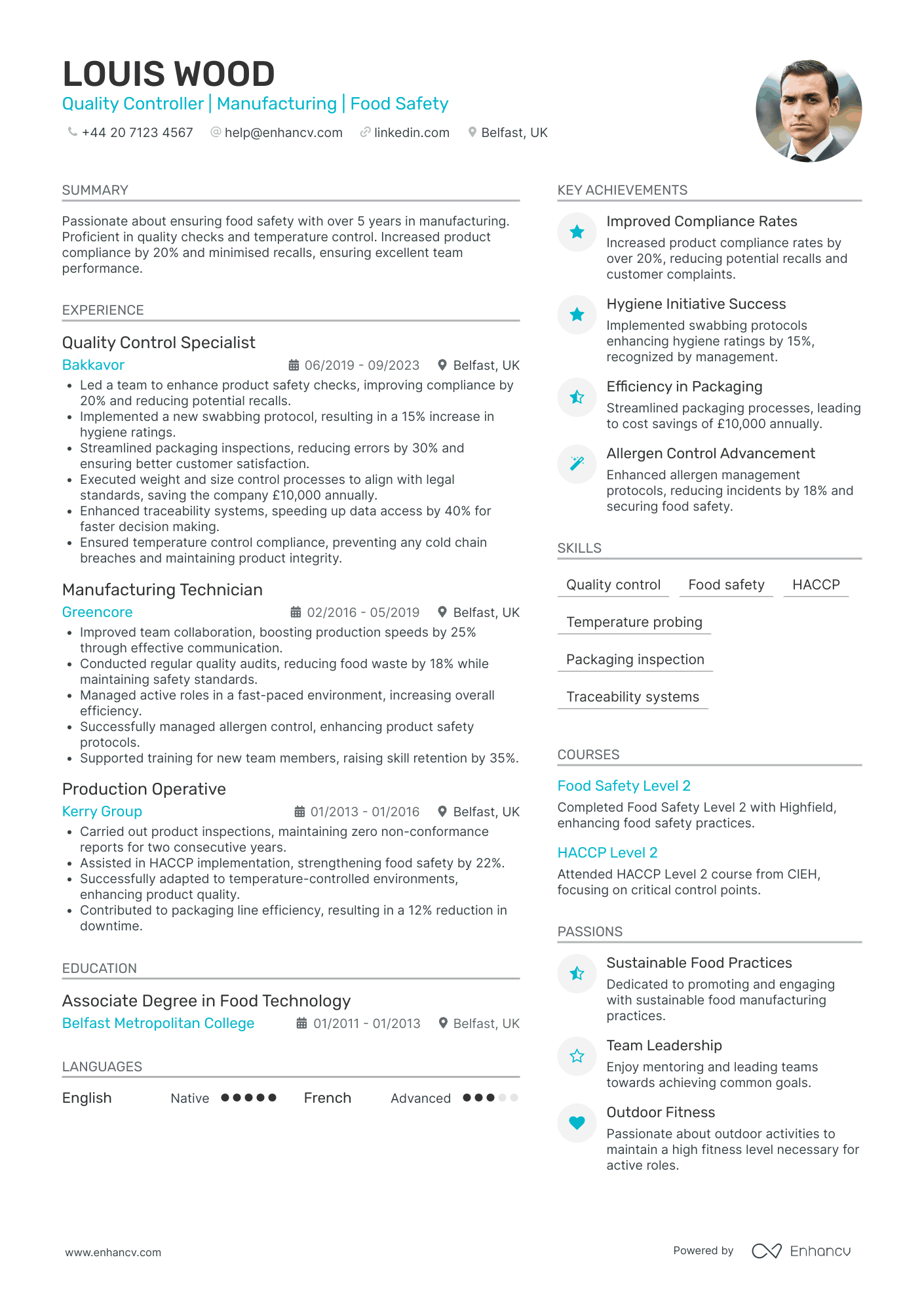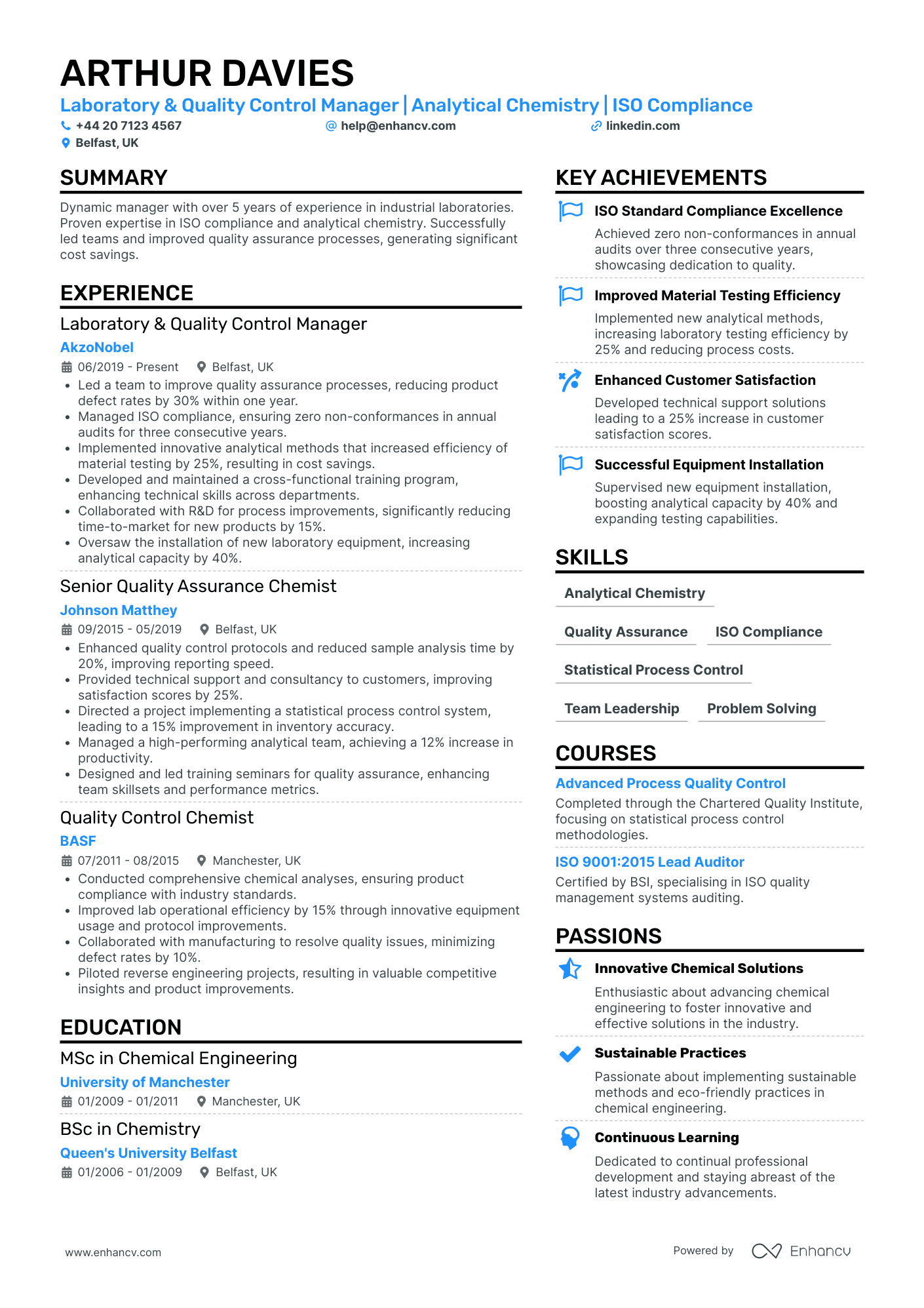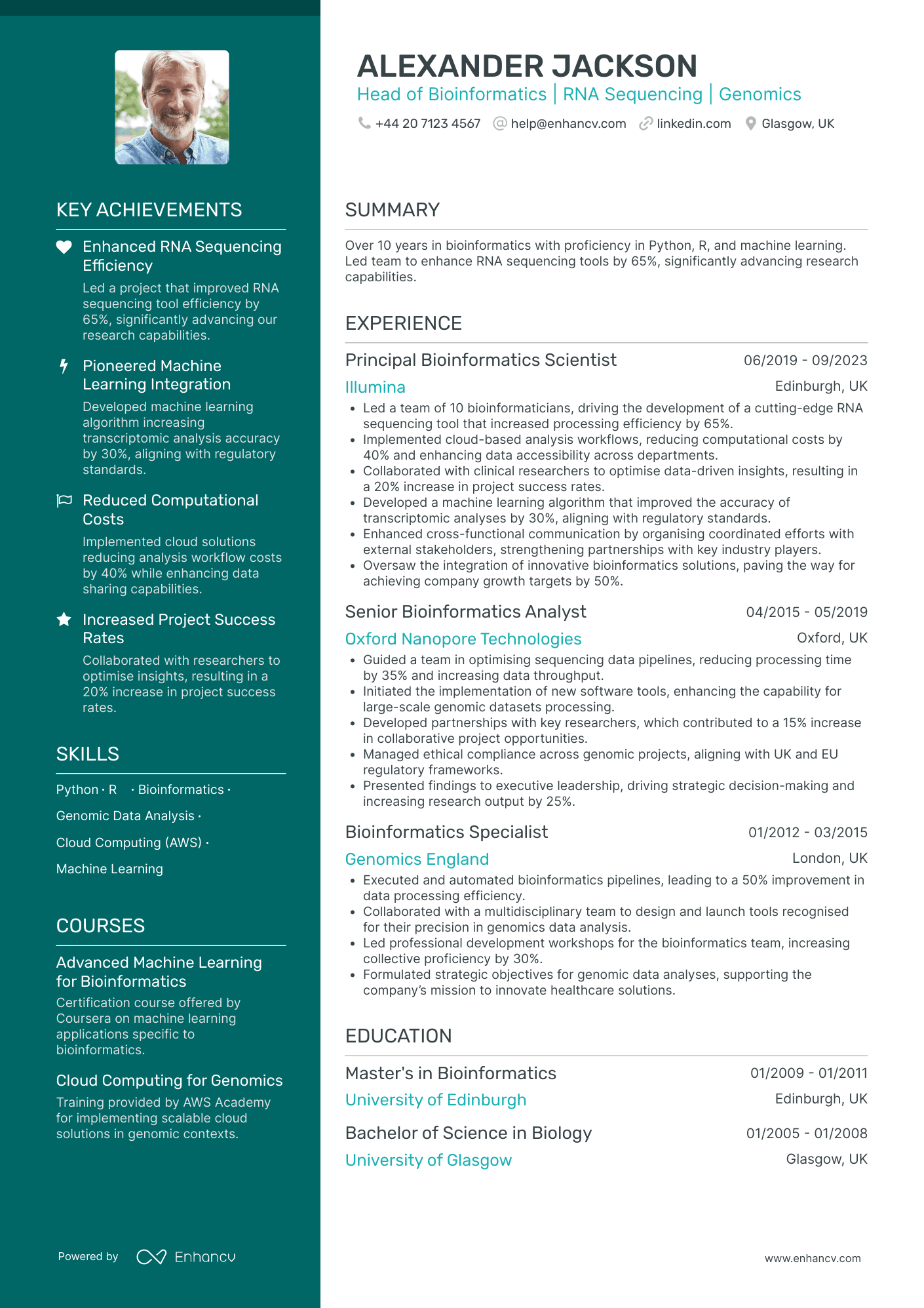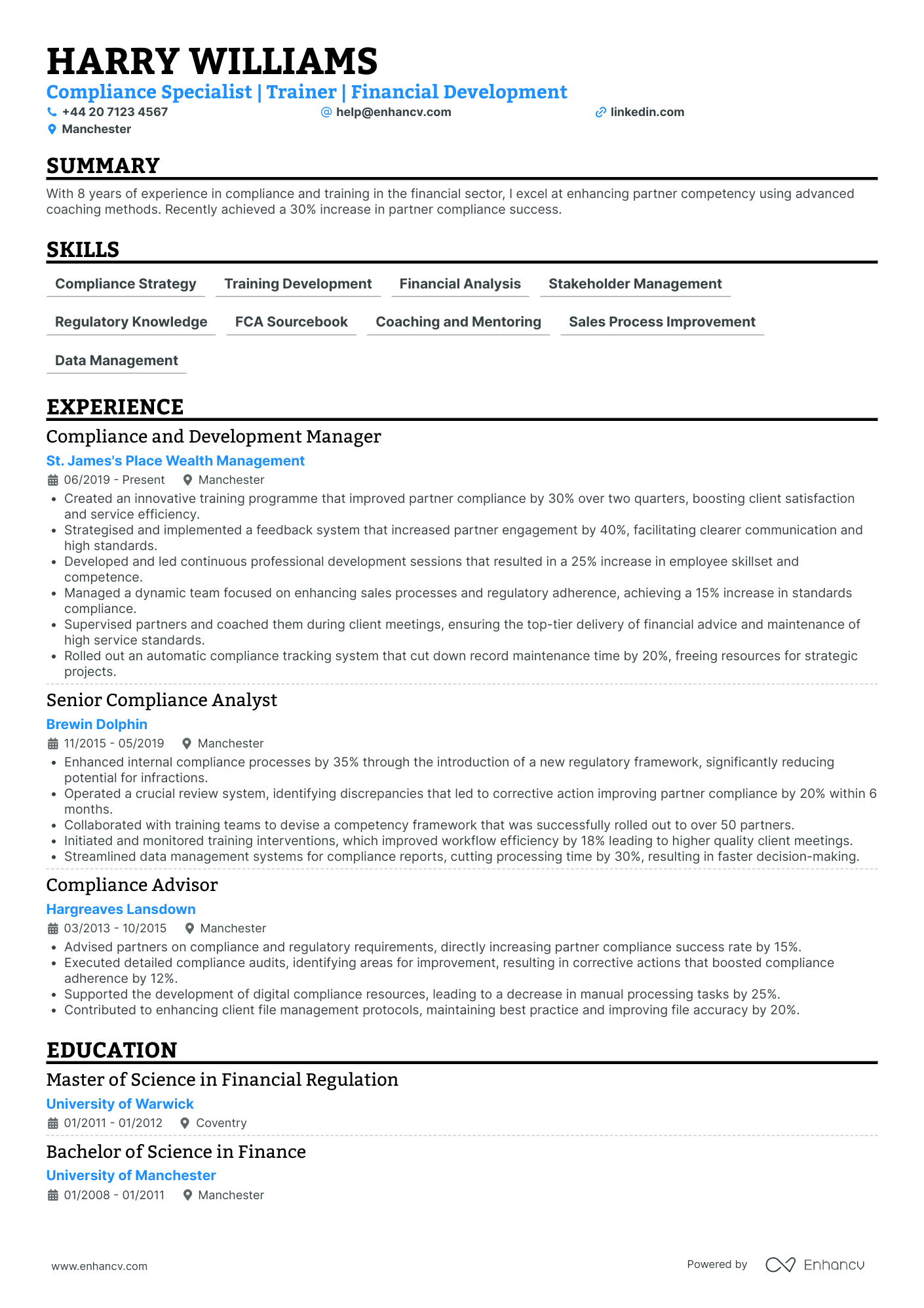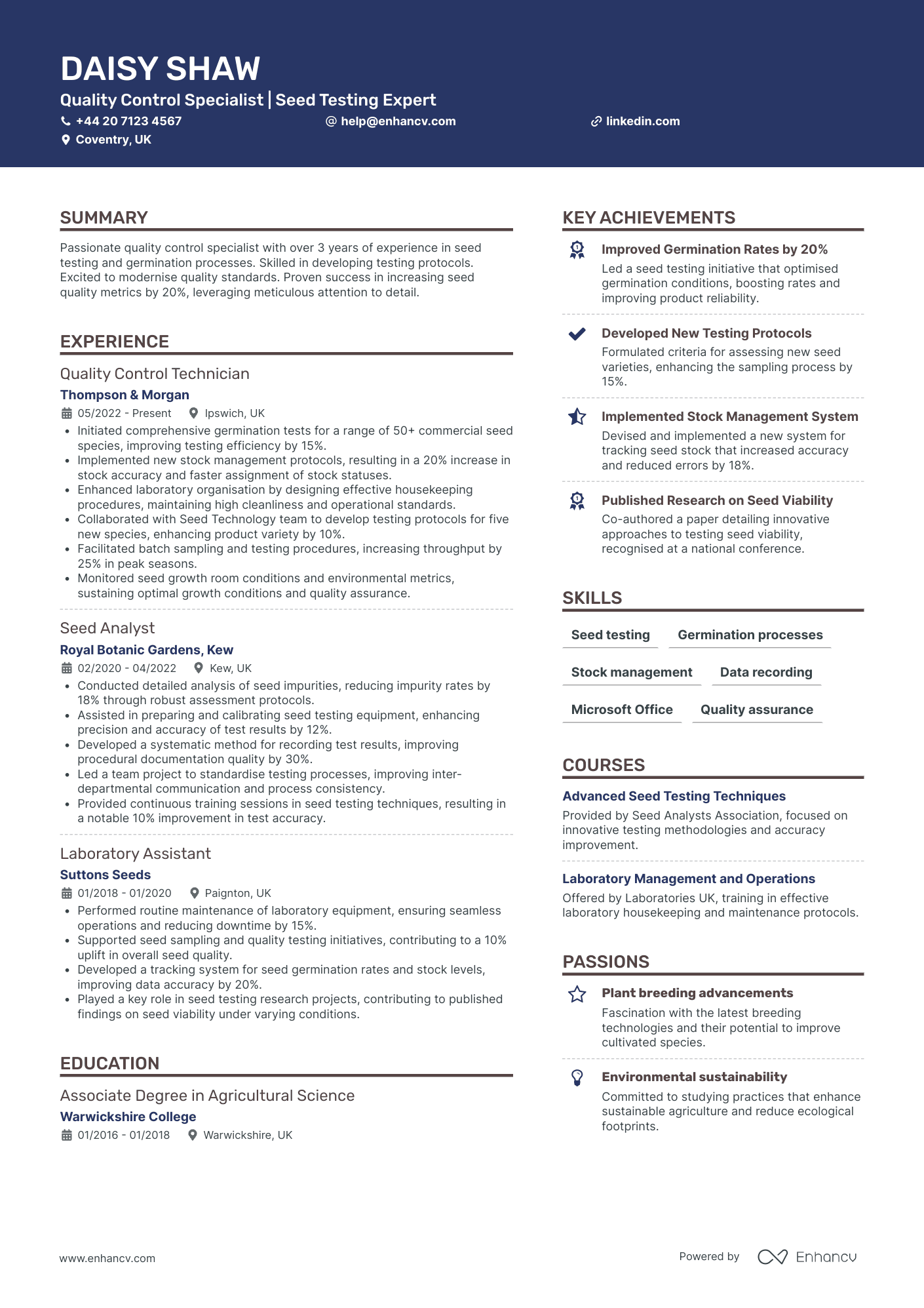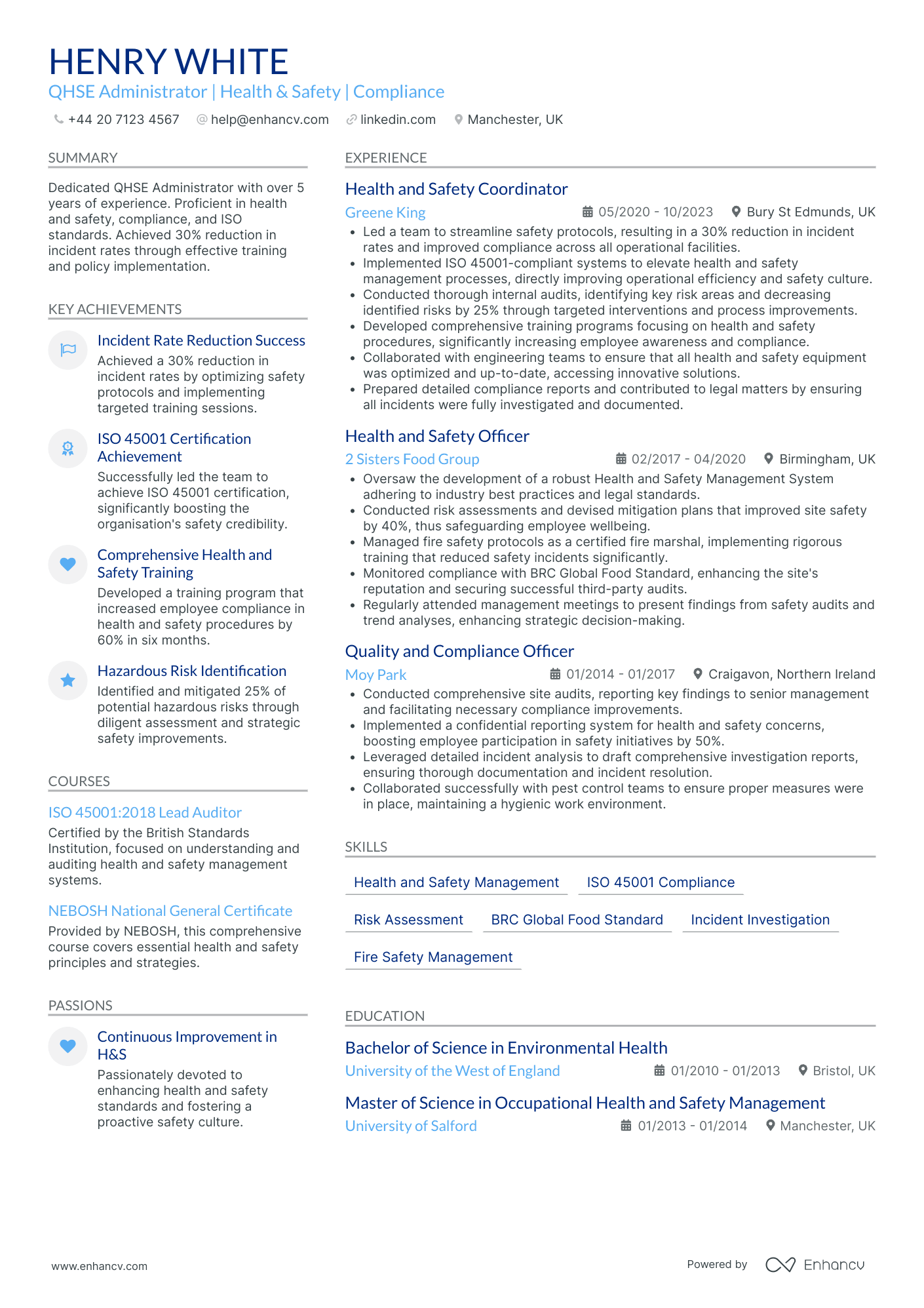Ensuring consistent detection of minor defects in complex products remains a formidable computer vision challenge within quality control efforts. Our guide provides you with step-by-step strategies and cutting-edge algorithms to enhance your system's accuracy and adaptability in pinpointing these elusive imperfections.
- Applying the simplest CV design, so that recruiters can easily understand your expertise, skills, and professional background;
- Ensuring you stand out with your header, summary or objective statement, and a designated skills section;
- Creating your CV experience section - no matter how much expertise you have;
- Using real life professional CV examples to enhance the structure and outline of your profile.
If you still have no muse to write your professional CV, find some more industry-leading examples.
Resume examples for quality control
By Experience
Junior Quality Control Analyst in Pharmaceuticals
- Structured and Engaging Presentation - The CV is well-structured with clear sections such as Experience, Education, Skills, Achievements, and Passions, which provide a comprehensive overview of the candidate's qualifications. Each section is articulated concisely, making it easy for the reader to follow and understand Harry’s professional journey.
- Demonstrated Career Advancement - The progression from a Compliance Intern to a Quality Control Analyst over the course of a few years illustrates a consistent career path focused on refining expertise in financial risk management and compliance. This trajectory reflects the candidate’s growth and increasing responsibilities across reputable companies.
- Emphasis on Achievements with Business Impact - Harry’s CV highlights achievements with quantifiable business results, such as reducing financial loss risks by 30% and increasing employee compliance scores by 25%. These accomplishments underscore the candidate's effectiveness in delivering tangible improvements that drive company performance.
Senior Quality Control Engineer in Automotive
- Clear and Structured Content Presentation - The CV is organized effectively, presenting a clear structure with well-defined sections covering experience, education, skills, achievements, and more. This level of clarity helps in the easy navigation and understanding of the candidate's qualifications and experiences, providing a succinct yet comprehensive view of their professional journey.
- Consistent Career Growth in Automotive Quality Control - Ella Bennett's career trajectory demonstrates a steady ascension in roles, from Quality Control Specialist to Senior Quality Control Engineer, reflecting her growing expertise and responsibility within the automotive industry. This progression highlights her commitment and ability in the field, as well as the recognition of her skill sets by top automotive manufacturers.
- Effective Use of Industry-Specific Tools and Methodologies - The CV highlights the candidate's proficiency with precision measurement tools like CMM machines and her implementation of methodologies such as root cause analysis and Six Sigma. These elements pinpoint her technical depth and capability to address specific industry challenges effectively, offering significant advantages to potential employers in the quality control sector.
By Role
Quality Control Manager in Manufacturing
- Content Presentation and Structure - The CV is excellently structured, leading with clear headers and sections that allow for easy navigation. Each section is concise, using bullet points effectively to outline key responsibilities and achievements. This presentation style ensures that the most important details are easy to find and comprehend, making the candidate’s qualifications immediately apparent.
- Career Trajectory and Growth - Mia Ward’s career trajectory demonstrates significant growth and development in the field of quality management. Moving from a Quality Assurance Specialist to a Quality Control Manager highlights her upward progression and increasing responsibilities. Her career path shows strategic moves within significant companies, indicating not only promotions but also a widening breadth of experience in different environments.
- Achievements and Business Impact - The CV emphasizes achievements that directly tie into business impact, going beyond mere numbers. Mia’s role in reducing quality nonconformances by 25% and improving production efficiency by 20% are not just statistics; they illustrate her ability to lead initiatives that enhance operational excellence and contribute significantly to organizational goals, such as customer satisfaction and compliance.
Quality Control Inspector in Construction
- Strategic Career Development - Elsie Murray's career trajectory is clearly delineated, showcasing her growth from a Construction Planner to a Senior Project Manager within a decade. Her advancement through reputable companies like Morgan Sindall, Kier Group, and Wates Group highlights her increasing responsibilities and expertise in the construction industry, signaling a pattern of strategic professional development and leadership capabilities.
- Strong Focus on Compliance and Risk Management - The CV underscores Elsie's deep understanding of regulatory compliance and risk management within the construction sector. By maintaining zero compliance issues and implementing corrective measures to ensure project safety, she demonstrates her commitment to adhering to industry standards and her proactive approach to risk assessment.
- Adaptability and Multi-faceted Skill Set - Elsie's diverse skill set, including proficiency in tools like Microsoft Project and AutoCAD, coupled with her knowledge of capital investment projects and construction management, makes her highly adaptable across various roles within the construction industry. This ability to operate cross-functionally ensures she can effectively support and lead complex projects while fostering collaboration across teams.
Quality Control Specialist in Food Processing
- Clear Structure and Conciseness - The CV is well-organized, with sections clearly delineating personal details, experience, education, skills, and achievements. This format allows for easy navigation and quick comprehension, making it straightforward for a hiring manager to identify key qualifications and accomplishments.
- Diverse Career Trajectory - Freya Richardson’s career shows a dynamic progression from an HR Specialist to a Quality Control Specialist, illustrating a strong growth pattern. Her transition between roles across different cities and companies reflects adaptability and a keen ability to leverage her HR experience in quality assurance contexts.
- Achievements with Quantifiable Impact - Specific accomplishments within her roles are emphasized with metrics, such as reducing error rates by 5% and enhancing operational efficiency by 20%. These figures not only reveal her competency and effectiveness but also underscore her contributions to larger business goals, showcasing her ability to create tangible, positive outcomes.
Quality Control Coordinator in Textile Industry
- Structured and Clear Presentation - The CV is well-organized, presenting information in a concise and logical manner. Sections are clearly labeled, making it easy to navigate through the candidate's background. Key details such as education, experience, and skills are effectively highlighted, ensuring that the reader can quickly grasp the candidate’s qualifications.
- Demonstrated Career Growth in Specialized Fields - Lucas Adams showcases a clear career progression from a QA Technician to a QA/QC Lead, with increasing responsibilities and expertise in environmental management and industrial operations. This trajectory demonstrates a strong ability to advance within the industry and adapt technical skills to leadership roles.
- Expertise in Industry-Specific Tools and Techniques - The CV reflects a high level of technical proficiency in industry-specific tools and methodologies, such as pH probes, 5-gas meters, and waste analysis techniques. This showcases the candidate’s ability to apply specialized knowledge in QA/QC processes and environmental compliance, positioning them as a valuable asset in their field.
Quality Control Auditor in Finance
- Comprehensive and Efficient Content Presentation - The CV is meticulously structured, offering a clear and concise overview of Theodore Green’s professional journey. Each section is well-organized, allowing easy navigation through the candidate's career history, educational background, and skill set, which facilitates quick comprehension of his qualifications and experiences relevant to quality control and compliance.
- Impressive Career Progression in Investigations and Compliance - Theodore’s career trajectory reflects a well-defined growth path in the field of investigations and compliance. Starting as a Research Assistant, he quickly advanced to more responsible roles such as Investigative Analyst and Quality Control Auditor, highlighting a steady progression that encapsulates increasing responsibilities and recognition in his ability to enhance investigative processes.
- Significant Achievements with Tangible Business Impact - Theodore's CV emphasizes achievements that have a direct business impact, such as a 40% reduction in unresolved cases at G4S and a 25% increase in compliance accuracy at Risk Advisory Group. These achievements demonstrate his critical role in boosting operational effectiveness and ensuring adherence to quality standards, underscoring the value he brings to an organization.
Quality Control Technician in Electronics
- Structured and Comprehensive Presentation - The CV is meticulously structured with distinct sections that convey clarity and conciseness. It opens with a strong summary that encapsulates Sophia's capabilities and experience succinctly, followed by well-organized experience, skills, education, and achievements sections. Each element is presented with clear bullets and quantitative data to enhance readability and impact.
- Career Progression and Leadership Development - Sophia's career trajectory reflects a strong upward movement from Junior EBME Technician to Senior EBME Technician, demonstrating her growth in responsibilities and leadership roles. Her career path within reputable NHS trusts shows her consistent commitment to healthcare technology and her capability to lead teams, thereby enhancing service delivery and patient care.
- Impactful Achievements with Business Relevance - The CV spotlights significant achievements like the Efficiency Improvement Project and Safety Compliance Initiative, focusing not just on numerical improvements (such as a 25% reduction in downtime) but also on their broader impact on clinical workflows and healthcare safety. These achievements highlight Sophia's ability to drive critical business enhancements in medical environments.
Quality Control Supervisor in Plastics Industry
- Strong Leadership and Team Facilitation - James Lewis’ CV highlights excellent leadership capabilities, particularly in managing a team of QA auditors. His role as a Senior Quality Assurance Coordinator at Dairy Crest Limited involves not only improving product quality standards but also fostering cross-functional collaboration and delivering comprehensive training to enhance team adherence to safety protocols.
- Remarkable Career Consistency and Growth - His career trajectory demonstrates steady progression in the quality assurance domain, reflecting a consistent commitment to food safety and compliance. From his initial role as a Food Safety Auditor at Wensleydale Creamery to becoming a Senior Quality Assurance Coordinator at Dairy Crest Limited, each position signifies an increase in responsibility and complexity, indicating dedication and growing expertise in the field.
- Industry-Specific Methodologies and Technical Proficiency - The CV stands out with its detailed references to industry-specific tools and methodologies. James showcases his proficiency with GMP, CCP, BRC Standards, and HACCP protocols, indicating a deep understanding of technical elements vital for ensuring food safety and quality compliance within dairy production and processing environments.
Quality Control Consultant in the Health Sector
- Structured Presentation of Qualifications - The CV is effectively structured with sections clearly curated to highlight the candidate's qualifications, such as summary, experience, education, skills, and achievements. This ensures easy navigation and quick identification of key information by potential employers.
- Progressive Career Trajectory - Florence Knight's career trajectory showcases an impressive growth from a Laboratory Analyst at Pfizer to a Senior Specialist at GlaxoSmithKline, demonstrating their ability to scale up responsibilities and expertise within the quality control and data management sectors in the pharmaceutical industry.
- Industry-Specific Technical Expertise - The CV highlights unique industry-specific skills such as Laboratory Information Management System (LIMS) management, KPI creation, and regulatory compliance, underscoring Florence's technical depth and proficiency in handling complex quality control processes.
Quality Control Director in Cosmetics
- Strong progression in career trajectory - The CV highlights a clear path of growth, with Finley Robinson moving from a Quality Assurance Associate role at Biogen to an Associate Director position in Quality Control. This trajectory reflects not only his increasing responsibilities but also his growing expertise in the cell and gene therapy field.
- Emphasizes cross-functional leadership and collaboration - Finley's experience section underscores his ability to lead cross-functional teams and collaborate with various departments, which is crucial in his role of overseeing method validation and product releases. This ability to work across teams enhances operational efficiency and project outcomes.
- Showcases adaptability with industry-specific methodologies - The CV stands out in its focus on specific tools and methodologies relevant to cell and gene therapy. By involving himself in method transfers and data management, Finley leverages specialized knowledge to improve compliance and align with regulatory expectations, making him a valuable asset in the field.
Quality Control Analyst in Information Technology
- Effective Content Presentation - The CV is structured with clarity and conciseness, making it easy for the reader to quickly identify key information. Each section is neatly presented, with bullet points highlighting the candidate's key responsibilities and achievements, ensuring that important details are not overlooked.
- Diverse Career Trajectory - Eva Fisher's career path demonstrates significant growth, starting from a Roof Installation Specialist and advancing to a Quality Control Supervisor. This progression reflects both her expanding expertise within the roofing industry and her ability to take on greater responsibilities, showcasing her continuous professional development.
- Achievements with Business Relevance - The CV effectively highlights achievements that have substantial business impacts, such as improving on-site team efficiency by 35% and maintaining a 98% safety compliance rate. These accomplishments not only demonstrate her competence but also emphasize her contributions to enhancing operational efficiency and safety within the business.
Quality Control Officer in Chemical Industry
- Strong career progression - Oscar Evans' CV effectively illustrates a strong career trajectory, moving from a Quality Assurance Engineer to more senior roles like Quality Control Manager and Senior Quality Control Engineer. This progression highlights his ability to take on increasing levels of responsibility and leadership in the civil engineering field.
- Emphasis on leadership and team management - The CV underscores his leadership capabilities, particularly in managing teams and enhancing quality compliance. His experience in leading training programs and liaising with cross-functional teams shows a versatile leadership style focused on achieving tangible improvements in quality control.
- Significant achievements with clear impact - Oscar’s accomplishments are not just numerical; they demonstrate a real impact on the business. For instance, his role in reducing rework instances by 50% and saving £200,000 annually signifies a substantial contribution to cost efficiency and quality improvement in projects.
Quality Control Lead in Steel Production
- Clear and Structured Presentation - The CV is expertly constructed, with concise and systematic sections. Each part, from professional experience to education and certifications, is well-organized, ensuring the reader can quickly grasp Ella’s qualifications. The use of bullet points under each experience entry enhances readability by clearly outlining her contributions.
- Strategic Career Advancement in Quality Control - Ella’s career trajectory illustrates a strategic progression from hands-on quality engineering at Tata Steel to senior and managerial roles at major companies. Her upward movement reflects not only an increase in responsibility but also a growing expertise in quality control management within the steel fabrication industry, emphasizing her leadership capabilities.
- Strong Focus on Industry-Specific Methodologies - The CV highlights Ella’s mastery of industry-specific standards such as AWS and AISC. Her expertise in Six Sigma and lean manufacturing methodologies showcases her technical depth, making her stand out as an expert capable of driving process improvements and achieving operational excellence within the steel fabrication sector.
Quality Control Associate in Retail
- Structured and Concise Presentation - The CV excels in clarity and organization, presenting Louis Wood's professional journey in a straightforward manner. Each section is well-defined and concise, making it easy to navigate through his experiences and accomplishments. The bulleted format used under each work experience effectively highlights key achievements and responsibilities.
- Progressive Career Growth - Louis' career trajectory showcases significant growth and advancement within the manufacturing and food safety sectors. Starting from a Production Operative, he moved up to become a Manufacturing Technician and finally a Quality Control Specialist, demonstrating a clear path of upward mobility driven by skill enhancement and leadership capabilities.
- Industry-Specific Expertise - The CV highlights specific tools and methodologies relevant to the food manufacturing industry, such as HACCP, temperature control, and swabbing techniques. These industry-specific details underline Louis' technical depth and proficiency in maintaining high safety and quality standards, essential for his role in quality control and food safety.
Quality Control Operations Manager in Logistics
- Logical presentation with a clear career progression - The CV is structured in a manner that clearly outlines the candidate's growth from a Quality Control Chemist to a Laboratory & Quality Control Manager. Each section is concise yet comprehensive, allowing the reader to easily follow the career trajectory while understanding the value Arthur has added to each role.
- Emphasis on leadership and cross-departmental collaboration - Arthur demonstrates strong leadership skills, successfully leading teams and developing cross-functional training programs. Additionally, his work with R&D on process improvements illustrates an ability to collaborate effectively across departments, an essential trait for roles that require strategic oversight.
- Exemplary achievements with tangible business impact - The CV highlights achievements like reducing product defect rates by 30% and increasing testing efficiency by 25%, which are presented with clear numerical evidence of business impact. These accomplishments not only reflect Arthur's technical skill set but also his ability to make a measurable difference on company performance.
Quality Control Scientist in Biotechnology
- Strategic Leadership in Bioinformatics - The CV offers a robust demonstration of leadership skills by detailing Alexander Jackson's role in overseeing teams and projects. His ability to guide a team of bioinformaticians and drive significant process enhancements stands out, particularly with achievements like developing cutting-edge sequencing tools and optimizing workflows that directly impact company growth and research success.
- Innovative Use of Machine Learning and Cloud Computing - A key strength in the CV is the emphasis on integrating machine learning and cloud computing into bioinformatics. By highlighting the development of algorithms that enhance transcriptomic accuracy and cloud-based workflows that cut computational costs, the CV underscores Alexander's commitment to technological advancement and operational efficiency, critical in the evolving field of genomics.
- Comprehensive Set of Relevant Skills and Achievements - Alexander's CV is noteworthy for its comprehensive display of a wide array of technical and analytical skills pertinent to bioinformatics, such as Python, R, genomic data analysis, and high-throughput sequencing. Additionally, the CV succinctly connects these skills to tangible business outcomes, illustrating their relevance through achievements like increasing sequencing efficiency and optimizing cross-department collaboration, which enhanced overall project success rates.
Quality Control Executive in Publishing
- Clarity and Structure of Content - The CV stands out with its clear and structured presentation, offering concise bullet points under each role to highlight key responsibilities and achievements. This format allows the reader to quickly grasp the candidate's contributions and expertise without wading through dense paragraphs, making it highly effective for busy hiring managers.
- Career Growth in the Financial Sector - The candidate demonstrates a strong career trajectory within the financial sector, progressing from a Compliance Advisor to a Compliance and Development Manager. This progression highlights their ability to take on increased responsibilities, including leading teams and developing training programs, which underscores a path of consistent advancement and industry commitment.
- Innovative Compliance Strategies and Achievements - The CV highlights specific achievements, such as a 30% improvement in partner compliance and a 25% increase in employee skills due to training initiatives. These achievements not only show the candidate's ability to implement impactful strategies but also emphasize their role in driving business improvement and enhancing the company's service standards.
Quality Control Assistant in Beverage Industry
- Clear and Structured Format - The CV is well-organized, presenting Daisy's professional journey in a logical flow from current to past roles. Each section is clearly delineated, allowing for easy navigation and understanding of her qualifications and experience. Conciseness is prioritized, ensuring that each bullet point provides valuable insights without overwhelming detail.
- Career Growth in Quality Control - Daisy's career trajectory showcases steady progress within the seed testing and quality control industry. Her advancement from a Laboratory Assistant to a Quality Control Technician reflects a deepening specialization and increased responsibilities. This progression underscores her commitment to honing her expertise in seed quality and testing methodologies, reinforcing her suitability for leadership roles within the domain.
- Domain-Specific Expertise - Daisy's CV highlights a rich array of industry-specific skills and methodologies, such as germination processes, equipment calibration, and developing testing protocols for new species. Her involvement in key projects, like enhancing testing efficiency and stock management accuracy, showcases her technical depth and ability to leverage specialized tools to improve core quality metrics.
Quality Control Administrator in Education
- Cohesive structure and clear focus - The CV is well-organized, beginning with personal details and a succinct summary that captures the essence of the candidate's experience in QHSE administration. Each section is neatly presented, making it easy to navigate through Henry White's educational background, experiences, skills, and certifications relevant to health and safety compliance.
- Illustrates career growth within the H&S sector - Henry's progressive career trajectory is apparent, moving from a Quality and Compliance Officer to a Health and Safety Coordinator. Each role demonstrates a deeper involvement in H&S, showcasing his commitment to enhancing workplace safety and compliance within different companies and contexts.
- Demonstrates profound impact through strategic achievements - The achievements section quantifies Henry's contributions, such as achieving a 30% reduction in incident rates. These accomplishments are not only numerical but also emphasize the tangible improvements in workplace safety and compliance, demonstrating the candidate’s successful implementation of strategic processes.
Formatting your quality control CV to meet the role expectations
Staring at the blank page for hours on end, you still have no idea how you should start your professional quality control CV. Should you include more colours, two columns, and which sections? What you should remember about your CV format is this - ensure it's minimalistic and doesn't go over the top with fancy fonts and many colours. Instead, focus on writing consistent content that actually answers the job requirements. But, how about the design itself :
- Use the reverse chronological order to showcase your experience, starting with your most recent role;
- Include your contact details (email address, phone number, and location) - and potentially your professional photo - in the header;
- Must-have CV sections include summary or objective, experience, education, and skills: curate the ones that fit your profile;
- Your professional quality control CV should be between one-to-two pages long: select the longer format if you have more experience.
A little bit more about your actual CV design, ensure you're using:
- plenty of serif or sans serif font (e.g. Montserrat, Exo 2, Volkhov) as they are Applicant Tracker System (ATS) compliant. Avoid the likes of Arial and Times New Roman because most candidates' CVs are in this typography.
When submitting your CV, are you still not sure what format it should be? Despite the myth that has been circling around, most modern ATS systems are perfectly capable of reading PDFs. This format is an excellent choice as it keeps all of your information intact.
PRO TIP
Use bold or italics sparingly to draw attention to key points, such as job titles, company names, or significant achievements. Overusing these formatting options can dilute their impact.
The top sections on a quality control CV
- Personal Details to contact the candidate.
- Professional Profile highlights expertise in quality.
- Key Skills section shows relevant abilities.
- Work Experience reflects quality control success.
- Education and Training indicate formal knowledge.
What recruiters value on your CV:
- Highlight your attention to detail by mentioning specific instances where your ability to identify defects or non-conformities led to improvements in product quality or process efficiency.
- Emphasise your understanding of quality control standards by listing relevant certifications, such as ISO 9001 or Six Sigma, that you have acquired or contributed to within organisations.
- Demonstrate your technical proficiency by including any experience with quality control tools and software, like statistical process control (SPC) or quality management systems (QMS), that you are adept at using.
- Showcase your problem-solving skills and ability to implement corrective actions by describing scenarios where you successfully managed to reduce waste or improve production processes.
- Include any leadership roles or collaboration in cross-functional teams where you influenced quality initiatives or trained peers in quality control methodologies and best practices.
Recommended reads:
Tips and tricks on writing a job-winning quality control CV header
The CV header is the space which most recruiters would be referring most often to, in the beginning and end of your application. That is as the CV header includes your contact details, but also a headline and a professional photo. When writing your CV header:
- Double-check your contact details for spelling errors or if you've missed any digits. Also, ensure you've provided your personal details, and not your current work email or telephone number;
- Include your location in the form of the city and country you live in. If you want to be more detailed, you can list your full address to show proximity to your potential work place;
- Don't include your CV photo, if you're applying for roles in the UK or US, as this may bias initial recruiters' assessments;
- Write a professional headline that either integrates the job title, some relevant industry keywords, or your most noteworthy achievement.
In the next part of our guide, we'll provide you with professional CVs that showcase some of the best practices when it comes to writing your headline.
Examples of good CV headlines for quality control:
- Quality Control Inspector | ISO 9001 Certified | 5+ Years in Manufacturing Oversight | Process Improvement Expert
- Senior QC Analyst | Pharmaceuticals Assurance | GMP Expert | Data Analysis | 10 Years' Experience
- Lead QA Engineer | Tech Sector Specialist | Agile Methodologies | ISTQB Certified | 8 Years in Quality Roles
- Quality Control Manager | FMCGs Expertise | Six Sigma Black Belt | Strategic Planning | 12+ Years' Track Record
- Junior QC Technician | Aerospace Materials Testing | Continuous Improvement | ASQ Membership | 2 Years Hands-On Experience
- Quality Assurance Supervisor | Food Safety Regulations | HACCP & BRC Standards | Team Leadership | 7 Years in QC
Catching recruiters' attention with your quality control CV summary or objective
Located closer to the top of your CV, both the summary and objective are no more than five sentences long and serve as an introduction to your experience. What is more, you could use either to entice recruiters to read on. Select the:
- Summary, if you happen to have plenty of relevant experience. Feature your most impressive accomplishments and up to three skills that are relevant to the job you're applying for;
- Objective, if you're just starting your career off. Provide your career goals and answer how you see the role you are applying for will match your professional growth.
Judging which one you need to add to your quality control CV may at times seem difficult. That’s why you need to check out how professionals, with similar to your experience, have written their summary or objective, in the examples below:
CV summaries for a quality control job:
- With over 10 years of dedicated experience in a pharmaceutical quality control environment, I have honed expert skills in analytical chemistry and regulatory compliance, culminating in a significant reduction of non-conformance incidents by 30% at my current post.
- Driven quality control specialist with 8 years of experience in the food and beverage industry, specialising in HACCP and ISO 22000 standards, and recognised for implementing a state-of-the-art quality management system that enhanced product consistency across multiple locations.
- Software developer with 6 years of experience transitioning into quality control, bringing a strong analytical mindset and coding expertise to efficiently troubleshoot and improve testing protocols in manufacturing settings.
- Seasoned marketing professional with a decade of strategic planning success, now pivoting to a quality control career, eager to apply my meticulous attention to detail and robust project management skills to ensure product excellence and customer satisfaction.
- Seeking to leverage my passion for perfection and a freshly acquired diploma in Quality Management to start a career in quality control, with the objective of contributing to continuous improvement initiatives and mastering industry-standard quality assessment techniques.
- A recent graduate with a Bachelor's in Industrial Engineering eager to enter the quality control field, aiming to utilise strong statistical analysis skills and academic knowledge in quality systems to support the delivery of high-quality products.
More detailed look into your work history: best advice on writing your quality control CV experience section
The CV experience is a space not just to merely list your past roles and responsibilities. It is the CV real estate within which you could detail your greatest accomplishments and skills, while matching the job requirements. Here's what to have in your experience section:
- Prove you have what the job wants with your unique skill set and past successes;
- Start each bullet with a strong, action verb, and continue with the outcome of your responsibility;
- Use any awards, nominations, and recognitions you've received as solid proof of your skill set and expertise;
- align your experience with the role responsibilities and duties.
For more help on how to write your CV experience section, check out the next section of our guide:
Best practices for your CV's work experience section
- Led a team of 5 quality control inspectors, achieving a 30% reduction in product defects by implementing a rigorous six-sigma focused training programme.
- Developed and maintained comprehensive quality control documentation, ensuring compliance with ISO 9001 standards and facilitating a 15% improvement in audit performance.
- Introduced a statistical quality control system which resulted in a 20% increase in overall production efficiency and product consistency across the manufacturing process.
- Managed cross-functional collaboration with R&D and production departments to identify root causes for quality issues, reducing customer complaints by 25% year-on-year.
- Implemented an automated defect tracking system, cutting response time for quality issues by half and boosting customer satisfaction ratings significantly.
- Conducted thorough training sessions on quality assurance policies and protocols, fostering a culture of continuous improvement and detail-oriented work amongst new hires.
- Orchestrated regular quality audits and coordinated with suppliers to uphold high-quality raw materials, which diminished material-related defects by 18%.
- Utilised advanced data analysis techniques to predict potential quality failures, preventing 40 instances of possibly defective products from reaching the market.
- Championed the adoption of a collaborative QC tool that streamlined communication between teams, enhancing process transparency and accountability in quality control measures.
- Led quality assurance initiatives for a new product line which increased customer satisfaction ratings by 25% within the first year.
- Implemented a comprehensive statistical process control program that reduced manufacturing defects by 15% and improved overall efficiency.
- Coordinated with cross-functional teams to develop and maintain a quality management system compliant with ISO 9001 standards, enhancing the company's market reputation.
- Introduced an automated defect tracking system which decreased product testing time by 30%, driving quicker time-to-market for new drugs.
- Played a key role in company-wide audit preparations, successfully passing all regulatory inspections without major findings.
- Supervised a team of 10 QC analysts, fostering a culture of continuous improvement and knowledge sharing.
- Managed the quality inspection process for all incoming raw materials, reducing material waste by 20% through stringent vendor assessment.
- Provided detailed monthly reports on quality metrics which were critical in strategic planning and resource allocation.
- Identified and resolved a critical compliance issue with packaging, averting a potential recall scenario.
- Orchestrated a lean six sigma project that reduced process variation resulting in enhanced product consistency and a 10% reduction in customer complaints.
- Authored the quality control manual that served as the blueprint for company-wide QC practices.
- Conducted comprehensive risk assessments for new product development, significantly mitigating potential quality issues pre-launch.
- Streamlined the batch release process through automation, drastically reducing release cycles from 5 days to 48 hours.
- Collaborated with R&D to integrate quality parameters early in the product design phase, ensuring higher initial compliance rates.
- Led weekly quality review meetings with production and supply chain management, aligning QC measures with broader operational goals.
- Implemented advancements in spectroscopic analysis methods, which elevated the precision of contaminant detection in raw materials by 40%.
- Championed a 'quality first' training series for all new hires reducing on-the-job quality errors by 25% within first 3 months of employment.
- Developed and calibrated analytical instrumentation, ensuring optimal performance for accurate and reliable quality assessment.
- Facilitated the transition to digital quality records management, which improved traceability and reduced document retrieval times by over 50%.
- Performed robust validation of laboratory equipment, ensuring compliance with GMP throughout all testing activities.
- Designed and led a company-wide initiative to reduce cross-contamination, resulting in a 20% improvement in QA pass rates.
- Overhauled the supplier qualification process, resulting in a 30% improvement in raw material quality and reliability.
- Chaired the Material Review Board, making critical decisions on non-conforming materials, which decreased material rejection rates by 15%.
- Spearheaded the development of a real-time quality dashboard that provided key metrics for executive decision-making and drove a culture of quality performance accountability.
What to add in your quality control CV experience section with no professional experience
If you don't have the standard nine-to-five professional experience, yet are still keen on applying for the job, here's what you can do:
- List any internships, part-time roles, volunteer experience, or basically any work you've done that meets the job requirements and is in the same industry;
- Showcase any project you've done in your free time (even if you completed them with family and friends) that will hint at your experience and skill set;
- Replace the standard, CV experience section with a strengths or achievements one. This will help you spotlight your transferrable skills that apply to the role.
Recommended reads:
PRO TIP
If you have experience in diverse fields, highlight how this has broadened your perspective and skill set, making you a more versatile candidate.
Key quality control CV skills: what are hard skills and soft skills
Let's kick off with the basics. You know that you have to include key job requirements or skills across your CV. For starters, take individual skills from the job description and copy-paste them into your CV, when relevant. Doing so, you'll ensure you have the correct skill spelling and also pass the Applicant Tracker System (ATS) assessment. There are two types of skills you'll need to include on your CV:
- Hard skills - technical abilities that are best defined by your certificates, education, and experience. You could also use the dedicated skills section to list between ten and twelve technologies you're apt at using that match the job requirements.
- Soft skills - your personal traits and interpersonal communication skills that are a bit harder to quantify. Use various CV sections, e.g. summary, strengths, experience, to shine a spotlight on your workspace achievements, thanks to using particular soft skills.
Remember that your job-winning CV should balance both your hard and soft skills to prove your technical background, while spotlighting your personality.
Top skills for your quality control CV:
Quality Assurance
Statistical Process Control (SPC)
Good Manufacturing Practices (GMP)
ISO 9001 Standards
Six Sigma
Quality Inspection
Data Analysis
Lean Manufacturing
Root Cause Analysis
Auditing
Attention to Detail
Problem-Solving
Communication
Teamwork
Adaptability
Organisational Skills
Critical Thinking
Time Management
Decision Making
Continuous Improvement
PRO TIP
If you have received professional endorsements or recommendations for certain skills, especially on platforms like LinkedIn, mention these to add credibility.
Further professional qualifications for your quality control CV: education and certificates
As you're nearing the end of your quality control CV, you may wonder what else will be relevant to the role. Recruiters are keen on understanding your academic background, as it teaches you an array of hard and soft skills. Create a dedicated education section that lists your:
- applicable higher education diplomas or ones that are at a postgraduate level;
- diploma, followed up with your higher education institution and start-graduation dates;
- extracurricular activities and honours, only if you deem that recruiters will find them impressive.
Follow a similar logic when presenting your certificates. Always select ones that will support your niche expertise and hint at what it's like to work with you. Balance both technical certification with soft skills courses to answer job requirements and company values. Wondering what the most sought out certificates are for the industry? Look no further:
PRO TIP
Order your skills based on the relevance to the role you're applying for, ensuring the most pertinent skills catch the employer's attention first.
Recommended reads:
Key takeaways
Your successful job application depends on how you well you have aligned your quality control CV to the job description and portrayed your best skills and traits. Make sure to:
- Select your CV format, so that it ensures your experience is easy to read and understand;
- Include your professional contact details and a link to your portfolio, so that recruiters can easily get in touch with you and preview your work;
- Write a CV summary if you happen to have more relevant professional experience. Meanwhile, use the objective to showcase your career dreams and ambitions;
- In your CV experience section bullets, back up your individual skills and responsibilities with tangible achievements;
- Have a healthy balance between hard and soft skills to answer the job requirements and hint at your unique professional value.
